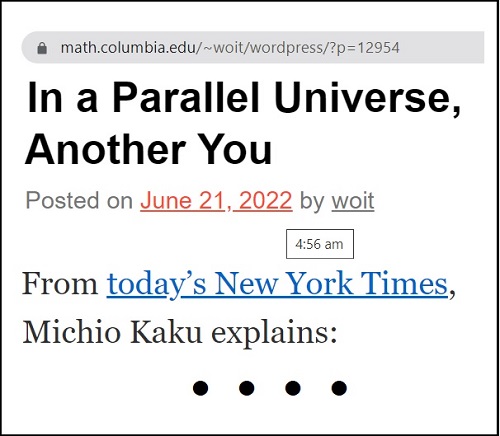|
From Heinlein's 1985 The Cat Who Walks Through Walls
… The World as Myth is a subtle concept. It has sometimes been called multiperson solipsism, despite the internal illogic of that phrase. Yet illogic may be necessary, as the concept denies logic. For many centuries religion held sway as the explanation of the universe- or multiverse. The details of revealed religions differed wildly but were essentially the same: Somewhere up in the sky-or down in the earth-or in a volcano-any inaccessible place- there was an old man in a nightshirt who knew everything and was all powerful and created everything and rewarded and punished… and could be bribed.
"Sometimes this Almighty was female but not often because human males are usually bigger, stronger, and more belligerent; God was created in Pop's image.
"The Almighty-God idea came under attack because it explained nothing; it simply pushed all explanations one stage farther away. In the nineteenth century atheistic positivism started displacing the Almighty-God notion in that minority of the population that bathed regularly.
"Atheism had a limited run, as it, too, explains nothing, being merely Godism turned upside down. Logical positivism was based on the physical science of the nineteenth century which, physicists of that century honestly believed, fully explained the universe as a piece of clockwork.
"The physicists of the twentieth century made short work of that idea. Quantum mechanics and Schrodringer's cat tossed out the clockwork world of 1890 and replaced it with a fog of probability in which anything could happen. Of course the intellectual class did not notice this for many decades, as an intellectual is a highly educated man who can't do arithmetic with his shoes on, and is proud of his lack. Nevertheless, with the death of positivism, Godism and Creationism came back stronger than ever.
"In the late twentieth century -correct me when I' m wrong, Hilda-Hilda and her family were driven off Earth by a devil, one they dubbed 'the Beast.' They fled in a vehicle you have met, Gay Deceiver, and in their search for safety they visited many dimensions, many universes… and Hilda made the greatest philosophical discovery of all time."
"I'll bet you say that to all the girls!"
"Quiet, dear. They visited, among more mundane places, the Land of Oz-"
I sat up with a jerk. Not too much sleep last night and Dr. Harshaw's lecture was sleep-inducing. "Did you say 'Oz'?"
"I tell you three times. Oz, Oz, Oz. They did indeed visit the fairyland dreamed up by L. Frank Baum. And the Wonderland invented by the Reverend Mr. Dodgson to please Alice. And other places known only to fiction. Hilda discovered what none of us had noticed before because we were inside it: The World is Myth. We create it ourselves-and we change it ourselves. A truly strong myth maker, such as Homer, such as Baum, such as the creator of Tarzan, creates substantial and lasting worlds … whereas the fiddlin', unimaginative liars and fabulists shape nothing new and their tedious dreams are forgotten. ….
|







